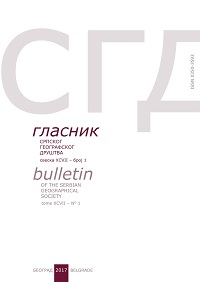Механизам настанка клизеће дробине на јужној падини Панчићевог врха (2017 m), Копаоник
Mechanism of genesis of sliding block fields on the south slope of Pančić's peak (2017 m), Kopaonik
Author(s): Boško Milovanović, Srđan Belij, Dragan NešićSubject(s): Physical Geopgraphy
Published by: Српско географско друштво
Keywords: Periglacijalna sredina; klizeća drobina; kurumi; kameni lednici; Kopaonik;
Summary/Abstract: Serbia is located approximately in the middle of the north temperate zone, i.e. in the central part of the Balkan Peninsula, where there are several mountains the highest parts of which enter the present periglacial altitude zone. One of those mountains is Kopaonik (2017 m), the highest parts of which enter the high-mountainous periglacial zone, above the upper forest border. Several forms and occurrences of periglacial environment have been registered on the southern border of presence and occurrence in the mountains of the South Eastern Europe. This is why these forms, as relatively rare phenomena, are significant and interesting for research, especially within periglacial geo-diversity of Serbia. New field research in Kopaonik established the occurrences of complex and slow thermogenic landslides (Nesic, D, Milincic, D, 2004), then frosty occurrences in the soil, such as sorting of creep or frosty grass hummocks – tuffs and migrating clods. There is a significant presence of detritus strata of soil destroyed by frost (Vasovic, M, 1988) and erosion nivation and frosty forms, whereas occurrences of sliding blocks are relatively rare. Especially, the occurrence of sliding block fields has been established (Belij, S, 1992), which is going to be the main subject of our consideration.
Journal: Гласник Српског географског друштва
- Issue Year: 89/2009
- Issue No: 4
- Page Range: 37-59
- Page Count: 23
- Language: English, Serbian

